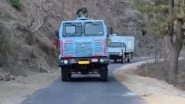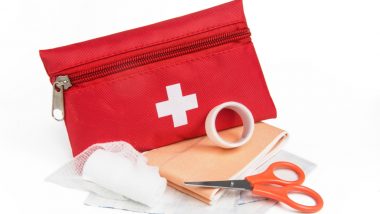The monsoons bring relief from the burning summers a sense of happiness among children and youngsters who love the showers. This however, is the busiest season for doctors across the country, as the rains bring along with itself viral, fungal and bacterial infections. Keeping a first-aid kit ready during the rains, is an ideal way to stay away from common illnesses and combat minor injuries. Whether you are travelling or at home, emergencies don't come knocking; its best to be prepared.
A handy little first-aid kit stored in an easily accessible place is a must, this help you with treating basic injuries and some common illnesses. This first aid kit should contain the following items:
- Anti-mosquito creams
- Pocket CPR mask
- Thermometer
- Fever medications (like Paracetamol)
- Anti-allergy medicines (like Cetrizine or Levocetrizine)
- Antacids (like Pantoprazole or Ranitidine or Gelusil) to combat acidity
- Antiemetics (like Ondansetron / Domperidone) to combat nausea or sensation of vomiting
- Analgesic sprays (like Volini) to combat pain and sprain
- Antiseptic solution like (Dettol or Savlon) to reduce the possibility of infection, sepsis
- Hand sanitiser
- Painkillers like Diclofenac/ Tramadol (check for allergies with doctor before stocking & consuming)
- Flashlight
- Betadine / Soframycin creams to apply on injuries
- Distilled water packs
- Gauze pieces, cotton rolls and pads
- Roll and crepe bandages

- Small scissors and tweezers
- Adhesive tapes
- Bandaids of different sizes, regular and waterproof
- A pair of disposable gloves
- A pair of extra warm clothes if large bag
- Spare mobile charger if outdoor
- List of important contact numbers for emergencies, that of your Physician, closest hospital and local ambulance services
In case of a fall or accident, follow these simple steps:
- Clean your hands priors to touching the person who has sustained injuries or cuts
- Wash the wound well, to clear out any dirt, apply antiseptic solution
- Apply Antiseptic ointment and dress the wound
- Keep the wound clean and dry to avoid infections
- In case of deep wounds, severe pain, deformity or excessive bleeding, seek medical help immediately
Apart from various emergencies, cold, cough, malaria, dengue, stomach infection, diarrhoea, fever, typhoid and pneumonia are some of the diseases which make it to the top of the list in this season. Here's how you can prevent these diseases;
1. Dengue and Malaria
These diseases are mainly spread by mosquitoes. Preventing mosquito bite is most important factor in preventing these diseases.
- Ensure improved water storage
- Ensure proper waste disposal
- Strictly avoid water stagnancy
- Use mosquito repellents during the day and night
- Use proper clothing with full sleeves
- The kit should contain mosquito repellants; symptoms such as fever, myalgia(pain) can be treated with medications in the kit.
2. Fever, Cold and Cough
Sudden weather change often causes viral fever, characterised by fatigue, chills, body aches and fever. The illness is contagious and spreads through infection droplets in the air, or by coming into physical contact with infected secretions. General duration of a viral fever lasts from 3-7 days, with the severity of the fever being the highest in the first three days.
- One must ensure that they do not get wet in the rain or stay in wet clothes for a long period
- Wash hands often
- Boost immunity by eating vitamin C-rich foods and green leafy vegetables. One must also keep a safe distance from an infected person.
- Medications to treat these flu like symptoms should be there in the first aid kit
3. Stomach Infection or Diarrhoea
Gastroenteritis or food poisoning are quite common during the monsoon season, and the high humidity helps in the growth of disease-causing bacteria. The common symptoms are abdomen pain, nausea, vomiting or diarrhea. Fever can develop, and one may feel sense of malaise or weakness through the course of the illness. Mainstay of treatment is hydration. Antacids, antiemetics along with probiotics can be used to treat this illness. First aid can include oral rehydration solutions (ORS) or powder.
4. Jaundice and Typhoid
These diseases are caused by contaminated food or by consuming food and water contaminated with the faeces of an infected person. Symptoms include high grade fever, nausea, vomiting, diarrhea and fatigue. Prevention includes providing clean drinking water, better sanitation, and proper handwashing. Aggravation of symptoms or poor oral intake needs medical attention.
5. Pneumonia
It is infection of lungs with wide range of possible causes and can affect any age group. It can be a serious or life-threatening illness. Symptoms resemble flu-like illness but can be severe. Prevention includes vaccination at childhood and even at adulthood. Other ways are:
- regular hand washing
- covering mouth and nose when coughing or sneezing
- refraining from smoking
- eating healthy
- exercising 4-5 days a week
6. Leptospirosis
Is an uncommon illness caused in monsoon, by bacteria transmitted from water contaminated by animal waste. Prevention may be achieved with protective clothing or by changes in association with animal husbandry. Minimise contact with fresh water and mud, that might be contaminated with the urine of infected animals. Usefulness of kit in this condition would be to treat symptoms like fever and myalgia. But once confirmed, it requires use of antibiotics after physician consult. Do not delay in consulting a doctor if unwell.
(This article has been contributed by Dr Md. Shakeel Ahmed Head Emergency & Trauma Dept., Fortis Hospital, Kalyan)
(The above story first appeared on LatestLY on Jul 16, 2018 06:03 PM IST. For more news and updates on politics, world, sports, entertainment and lifestyle, log on to our website latestly.com).













 Quickly
Quickly


